The Two Phases of the Housing Bubble: Part I

A Fannie Mae Commentary in December 2011 looked at the international scope of the housing bubble of the last decade. In this commentary, we look at the scope of the housing bubble in the United States.
Exhibit 1 shows the first several years of the millennium saw real house prices (i.e., house price increases above the general rate of inflation) rise rapidly in the U.S. In contrast, real disposable income per person barely crept upwards. Between the beginning of 2000 and the middle of 2006, real home prices increased nearly seven times as rapidly as real per capita income – 67% versus 10% (although due to the subsequent crash in house prices, the two series were nearly back in synch with each other by the middle of 2008).
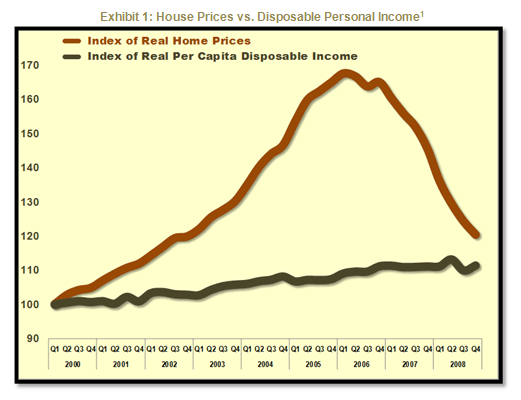
Given such circumstances, one would have thought that housing affordability would have become an increasing problem throughout the decade. It seems like simple pocket science: It becomes increasingly difficult to afford a big-ticket item if its price is rising a lot faster than your income.
But that did not happen uniformly throughout the housing bubble and there was a big difference in the first half of the period compared to the second. This can be seen in Exhibit 2 and Exhibit 3.
Exhibit 2 graphs an index of real home prices2 against an index of housing affordability.3 In order to bring out the patterns more clearly, Exhibit 3 draws best-fit curves though the data in Exhibi 2.
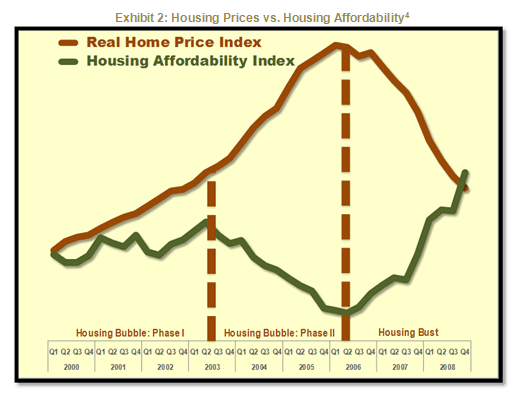
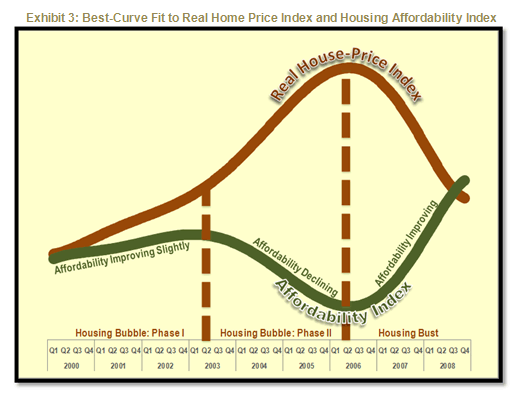
During the first part of the decade, up until the middle of 2003, houses actually became a bit more affordable in spite of the fact that they were rapidly getting more expensive – a fairly counterintuitive turn of events given that the typical person’s income wasn’t growing very much. Then between mid-2003 and mid-2006, houses became less affordable. How come this discrepancy between the two periods?
House prices and income are only two of the factors that determine whether homes are affordable or not. Most homebuyers have to borrow most of the price of their home. Thus, assuming a family has a sufficient down payment, the third major factor in determining affordability is the price of the funding needed to cover the price of the home. This is the mortgage interest rate.
Exhibit 4 shows that interest rates decreased significantly for both fixed-rate and adjustable-rate mortgages between 2000 and the middle of 2003. The reduction in rates more or less offset the increase in house prices during this period.
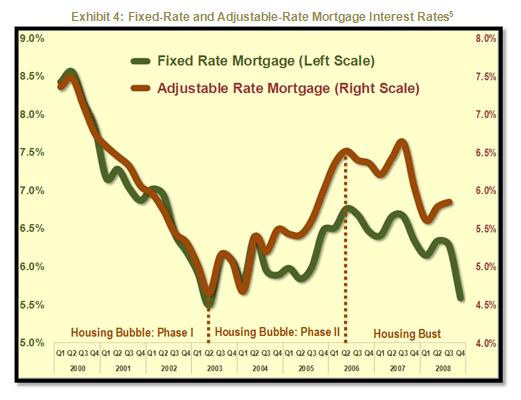
Starting in the second half of 2003, interest rates at first leveled off and subsequently started to rise. But since house prices continued to rise while interest rates swung from being a tail-wind to a head-wind, houses became less affordable – as depicted above in Exhibit 3. This period also coincided with the explosion of non-traditional mortgage finance, much of it provided by private-label securitization (PLS).
Phase II of the housing bubble saw a significant ceding of market share from the Government National Mortgage Association (GNMA) and the government-sponsored enterprises (Fannie Mae and Freddie Mac) to the PLS market. The shifts in market share are almost exactly in phase with the different stages of the housing bubble – as is shown in Exhibit 5.6
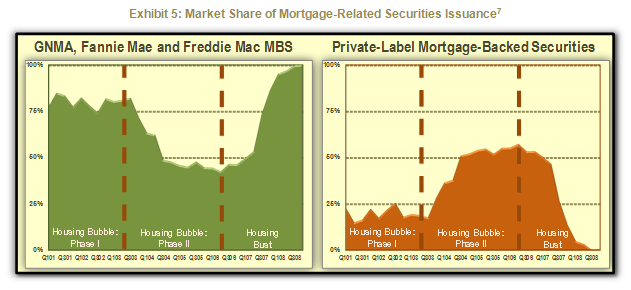
In late 2003, PLS began a rapid rise in their share of the market for mortgage-related securities, shooting up in the space of a year from 18% in the third quarter of 2003 to 51% in the third quarter of 2004. Their share subsequently reached a peak of 57% in the second quarter of 2006 before beginning a rapid decline thereafter.
The shift in market share was also accompanied by the growth of nontraditional mortgage products. A recent paper published by the National Bureau of Economic Research documented these changes in the market during the 2003-2006 period:
Financial innovation, in the form of non-traditional mortgage products and the expansion of alternative lending channels, namely non-agency securitization [i.e., PLS], fundamentally altered the mortgage landscape during the boom. … [N]ontraditional products, such as hybrid ARMs8 and negative amortization9 contracts, appeared on the scene. … These new products were financed largely through the expansion of private label securitization…
Loans with non-traditional amortization structures such as option ARMs10 or interest only loans also experienced rapid growth during the housing boom in the 2000s. From 2003 through 2005, the originations of these loans grew from less than 10% of residential mortgage originations to about 30%. Option adjustable rate mortgages experienced particularly dramatic growth. They accounted for as little as 0.5% of all mortgages written in 2003, but their share soared to more than 12% of all originations in 2006.11
When the housing bubble burst after the middle of 2006, these new types of mortgages caused especially severe problems. We will examine the fallout in Part II of this Commentary. In the meantime, Exhibit 6 gives a preview of the findings using delinquency data published by the Federal Housing Finance Agency (FHFA), the federal regulator of Fannie Mae and Freddie Mac.
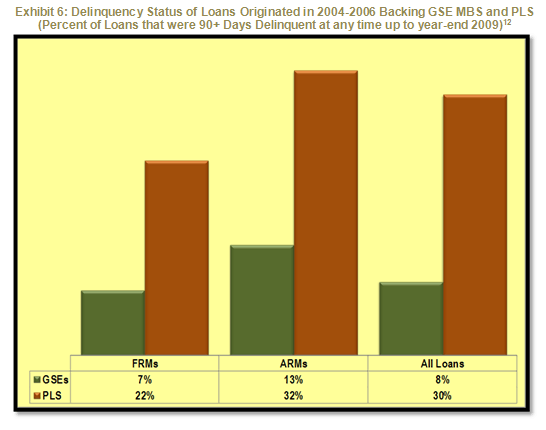
Looking at loans made from 2004 through 2006, adjustable-rate mortgages (ARMs), which cover most of the new nontraditional products, had significantly higher delinquency rates than fixed-rate mortgages (FRMs).13 Also loans financed by PLS performed much worse than the loans financed by GSE mortgage-backed securities (MBS). As the analysis in Part II will show, the difference in performance between PLS and GSE MBS arises both from the mix of loans in each sector and the performance disparity between the sectors – even taking the difference in product mix into account.
Noel Fahey
Director, Economics and Strategic Research
March 8, 2012
The views expressed in these articles reflect the personal views of the authors, and do not necessarily reflect the views or policies of any other person, including Fannie Mae or its Conservator. Any figures or estimates included in an article are solely the responsibility of the author.
1 Sources: CoreLogic (House Price Index), Commerce Department Bureau of Economic Analysis (Per Capita Disposable Personal Income) and U.S. Bureau of Labor Statistics (Consumer Price Index).
2 A price index is a way of tracking changes in prices for a class of goods, such as houses. It usually has a base or reference date where the index is set to 100. If prices increase in the next period by 5%, the value of the index would rise from 100 to 105. If prices instead decreased by 5%, the index would fall from 100 to 95. An index of real house prices (as opposed to an index of nominal house prices) adjusts changes in house prices by taking out the effect of general inflation, as measured by some general index such as the well-known consumer price index. Thus, if the house prices increased by 5% from the 100 level and prices in general increased by 3%, the index of real house prices would go from 100 to 101.94 (which is 105 divided by 1.03). Note that real house prices would have increased by 1.94%, (i.e., 101.94 ÷ 100 – 1 = 1.94%) not by the 2% that one would get by subtracting 3% inflation from the 5% nominal price increase.
3 See https://www.realtor.org/research/research/hameth for an explanation of the Housing Affordability Index. Basically, the index measures the extent to which “the median income family can qualify for a mortgage on a typical home.”
4 Sources: CoreLogic (House Price Index) and National Association of Realtors (Housing Affordability Index).
5 Source: Federal Housing Finance Agency, https://www.fhfa.gov/Default.aspx?Page=252, Tables 19 and 25. Note that different scales (left for FRMs and right for ARMs) are used for fixed-rate and adjustable rate mortgages in order to bring out the similarity of the underlying patterns.
6 The Federal Reserve Bank of Cleveland notes a similar pattern in the demand for mortgages from commercial banks: “An interesting thing to note here is that when the housing market was at its peak from the middle of 2003 to 2006, commercial banks reported sharply declining demand for residential mortgages. A probable cause for that could be that more mortgages were obtained from nonbank lenders at the time, and thus, demand for borrowing from banks decreased even while the market was booming.” Economic Notes, December 2009, page 24 (https://www.clevelandfed.org/research/trends/2009/1209/ET_dec09.pdf).
7 Sources: Bond buyer, Bloomberg, Inside MBS & ABS and company reports. The PLS numbers include MBS backed by jumbo and second-lien mortgages.
8 Hybrid ARMs are mortgages where the interest rate is fixed for the first few years (two or three years, for instance) and then fluctuate after the reset date is reached.
9 A negative amortization mortgage is one where the monthly payment is insufficient to cover the amount of interest and principal owed each month. The deficiency is added to the loan balance which increases.
10 Option ARMs (or “pick-a-payment” ARMs) are loans which allow borrowers to pick one of several options between a specified minimum amount and a full payment.
11 Mortgage Financing in the Housing Boom and Bust, Benjamin J. Keys (University of Chicago), Tomasz Piskorski (Columbia GSB), Amit Seru (University of Chicago and NBER) and Vikrant Vig (London Business School), National Bureau of Economic Research, December 28, 2011, paper abstract and pages 1 and 9 (https://www.nber.org/chapters/c12624.pdf).
12 Source: Federal Housing Finance Agency, Appendix Tables B-1 and B-3 at https://www.fhfa.gov/Default.aspx?Page=313.
13 We have dated the second, more problematic, part of the housing bubble to the period from the middle of 2003 through the middle of 2006. However, the FHFA data are given for full years only. Thus, we have picked originations for the full year 2004 through the full year 2006 as the period most closely approximating the dates we are interested in.
